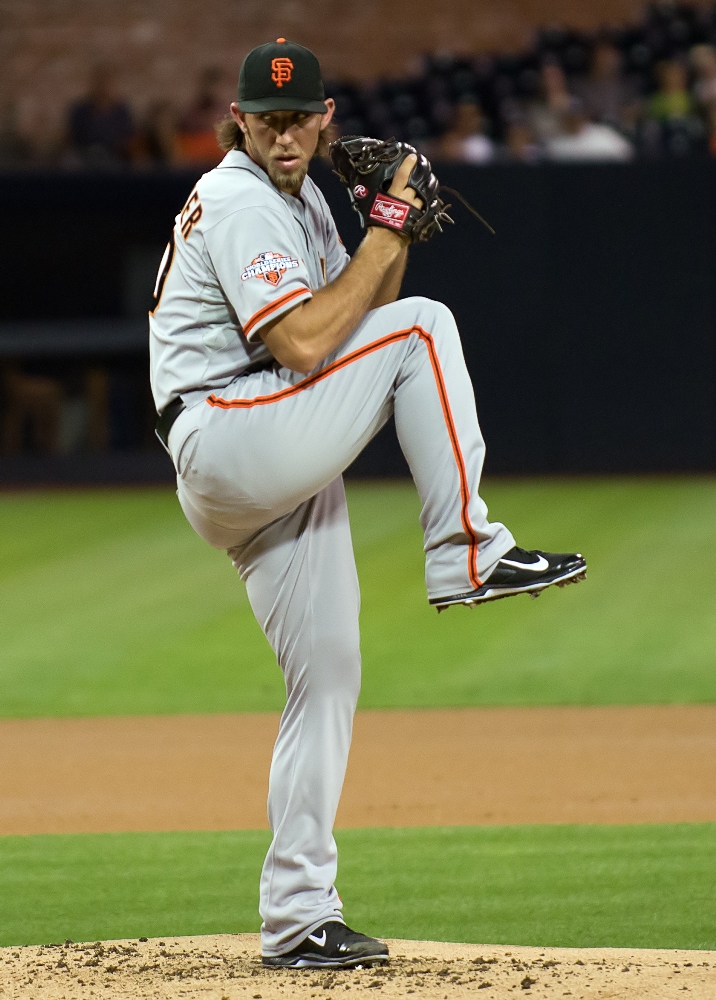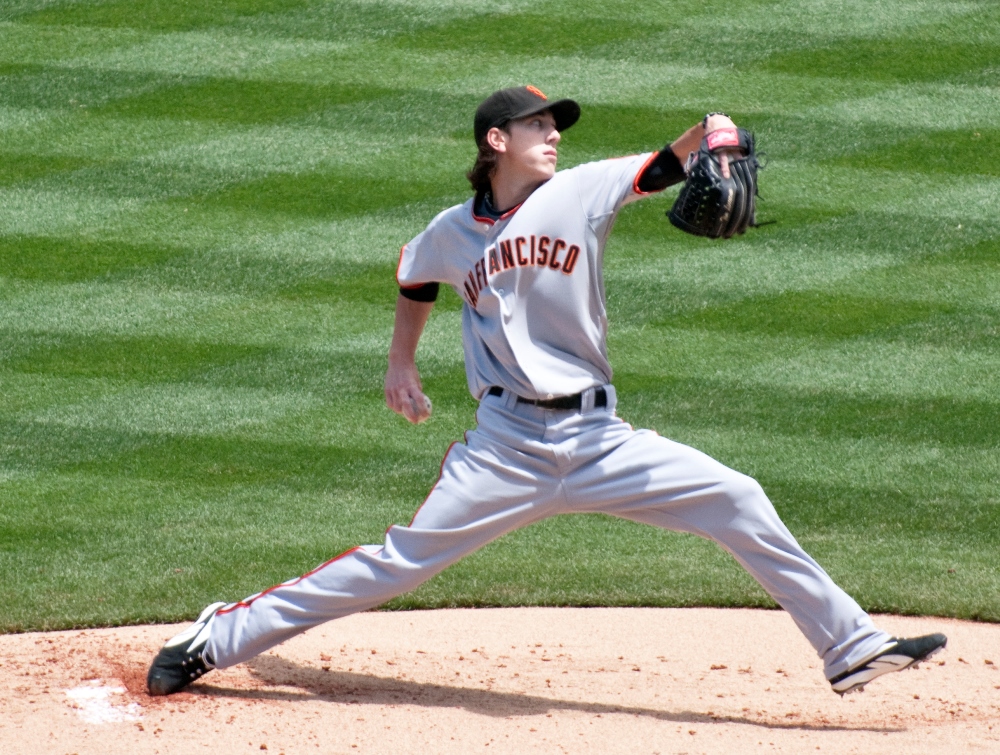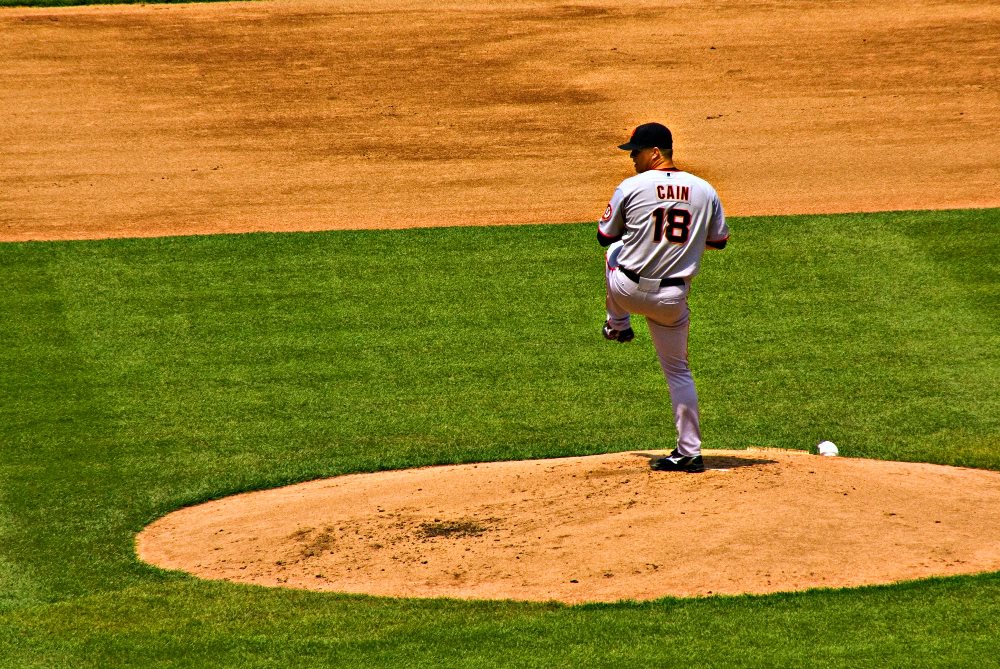
How the Giants Throw No-Hitters
Phil Kesten
Baseball season is right around the corner. Let’s wonder a bit about how major league pitchers get their pitches to curve, sink, and slide.

Madison Bumgarner
Madison Bumgarner throws a cutter that baffles the hitter, sending the San Francisco Giants back to the dugout while the batter stands, frozen, at the plate. Matt Cain, who tossed the first perfect game in Giants’ history, strikes out opposing batters in bunches with a dazzling fastball that crosses the plate high in the strike zone. Ex-Giant Tim Lincecum threw two no-hitters, relying heavily on a wicked slider that induced batters to hit weak easy-to-field ground balls.
How do pitchers like Bumgarner, Cain, and Lincecum make a small, white ball with red stitching rise, sink, and curve? What determines the path that a pitched ball follows?
Effects of Gravity
Certainly, gravity affects the path of the ball. No matter how a ball is thrown, and no matter whether the day is windy or calm, gravity pulls on every thrown baseball. Gravity always pulls straight down. In the absence of other effects, then, a pitched baseball will fall to Earth as it travels toward the plate.
Air Resistance
Air resists the forward motion of the ball. As the ball pushes through the air, the air pushes back – air drag always pushes on the ball in the direction opposite to the motion of the ball. In the absence of other effects, then, a pitched baseball slows down as it travels toward the plate.

Tim Lincecum
Rotation and Spin
The amount of rotation that a pitcher imparts to the ball affects the motion of a pitch. In particular, the way air moves around near the ball, and the wake the ball leaves behind it, can significantly change the path the ball follows.
Imagine a ball thrown with spin. Air rushes backwards past the ball as it flies toward the plate. The rotation of the ball, aided by the raised stitching that encircles it, drags air along ball’s surface. Air dragged along on the side of the ball spinning away from the plate is pushed along by the onrushing air. Air dragged along on the side of the ball spinning toward the plate has to fight against the wind. This causes air to pile up just a bit on the side spinning toward the plate, pushing the ball away from this side. The ball curves as it travels to the plate.
Stitches on a Baseball
Stitches reduce the effect of turbulent air in the wake behind the ball. So surprisingly, this reduces air drag on the ball – the drag on normal baseball can be as much as half that on a similar ball with no stitching. It’s unlikely that major league pitches could hit 95 or 100 miles per hour if the ball were smooth.

Matt Cain
A “Rising Fastball”
Matt Cain, like most pitchers, releases his fastball with a lot of backspin. That means the bottom side of the spinning ball is moving toward the plate, while the top side is spinning away. This results in an upward push on the ball. Not big enough to overcome gravity, but enough to keep the ball from falling toward the Earth as fast as it would have otherwise. A good “rising fastball” will arrive at the plate as much as two feet higher than it would have due to gravity alone.
The “Cutter” and “Slider”
Madison Bumgarner’s cutter and Tim Lincecum’s slider are similar pitches. Thrown a few miles per hour slower than a fastball – which gives the ball more time in flight to move from one side of the plate to the other – the cutter and slider are thrown with some sideways spin. A cutter breaks away from the throwing arm. A slider breaks away and also down.
The “Knuckleball”
Most major league pitched balls rotate fifteen or twenty times before reaching the plate. Spin makes the ball’s motion more stable by reducing the turbulence behind it. A knuckleball, however, is thrown with almost no spin - the lack of spin makes the motion of the ball unpredictable. The Toronto Blue Jays’ R.A. Dickey throws a ball that rotates only about twice before it gets to the plate. Dickey’s knuckleball often changes direction dramatically in just a fraction of second, mystifying batters and sometimes the catcher as well!
You don’t have to understand the physics of a thrown baseball to enjoy the game, but there’s a lot of interesting science to be found on the baseball diamond. Like Yogi Berra said, “you can observe a lot by watching.”
-----------------------------------------------
Questions to ponder:
You often hear baseball commentators talk about the dominant hand of a pitcher versus that of the batter, for example, a “leftie versus righty” matchup. The typical technique pitchers use to impart sideways spin to a ball results in it moving in a direction that crosses in front of his body. That is, a right-handed pitcher’s slider moves from right to left, and a left-handed pitcher’s slider moves from left to right. How does this affect these handedness matchups?

